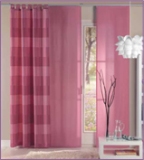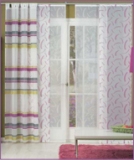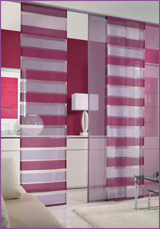|
||
| Impressum | ||
|
Sliding curtains − In the course of time (Schiebevorhänge)In history movable textile walls have appeared in many different cultures. For several centuries the Japanese have used sliding curtains and sliding panels as an architectural component of their houses. Above all, harmony plays an important role when it comes to interior design. In harmony with nature, they can therefore adapt the atmosphere in their houses to the light and thermal conditions. Also the residents‘ human need for quietness or company was to be served with these variable elements of decoration. They were used instead of windows and doors and could − depending on the purpose − consist of different materials. Take, for example, the creation of insulating and opaque areas made of thin wood or bamboo. Coverings made from paper or silk provided light and transparency. One could use them as scenery for a shadow theatre or made them by artful painting a decorative treasure in the room. This tradition has found admirers around the world and interior design in the Japanese style has meanwhile become a trend. A slightly modified form of the panel curtain can also be found in our cultural history. The folding-screen − as much handy as decorative. Here, three or more surfaces were covered with textiles and joined, so that when arranged in a zigzag or in a semicircle they result in the partitioning of the room. It also worked well as sun protection or privacy shield in front of a window or as changing room as well as hideout for a lover or the like that you wanted to shield from curious looks. The design of the surfaces completely depended on the owner‘s taste, mostly exclusive fabrics were used for the covering of a folding-screen, but also plain versions found their way through history up to the present. You can still find folding-screens with wheels today, e.g. in hospitals as screening between the beds of the patients. (Schiebevorhänge, Schiebewände, Flächenvorhang, Paravent, Bespannung) |



